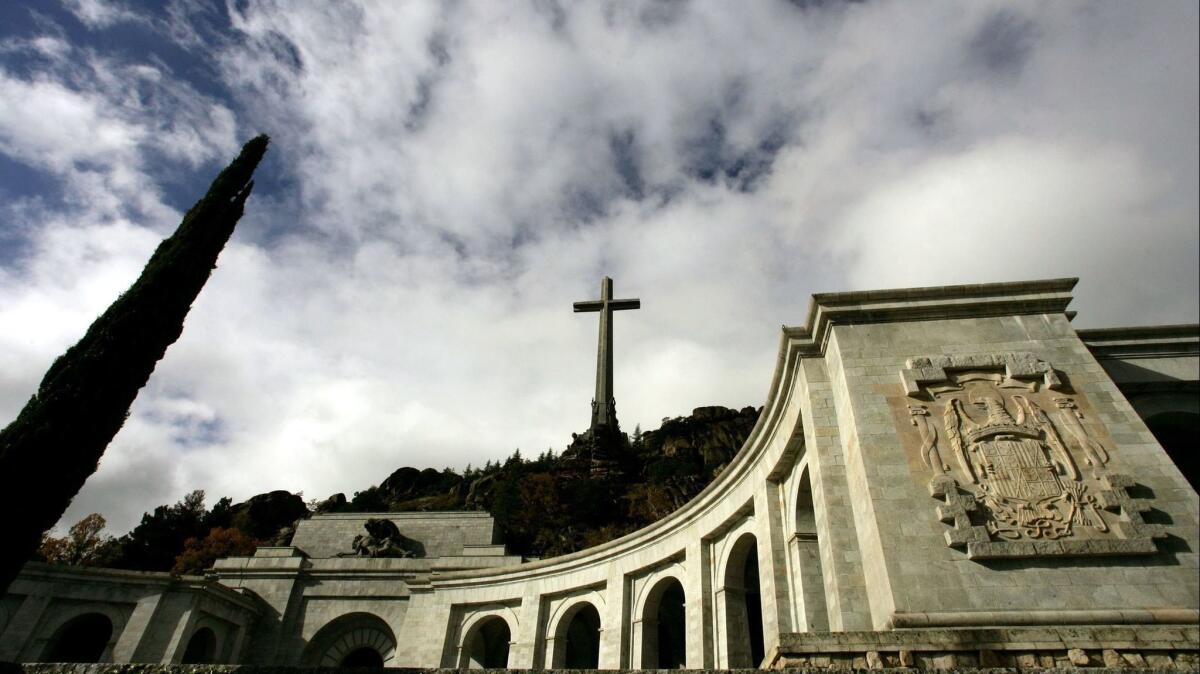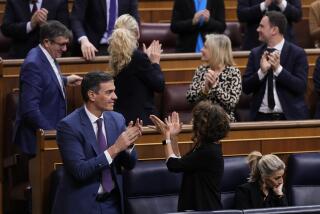Inside the Valley of the Fallen, a search for two brothers killed in the Spanish Civil War

In the decades since Francisco Franco’s death, the Spanish dictator’s colossal Valley of the Fallen mausoleum has stood untouched in the rolling countryside outside Madrid, guarded by a towering cross.
Run as an abbey by Benedictine monks on a site owned by the state, Franco’s monument has survived Spain’s transition to democracy, socialist governments and a host of experts pressing to remove the generalissimo’s body and turn the mausoleum into a modern museum for a democratic era.
Above all, the site has remained beyond the reach of families hoping to retrieve the remains of relatives they never wanted buried there alongside the dictator and the bodies of more than 33,000 victims of the brutal civil war he started.
Until now.
Late last month, the first beams of light illuminated the vaults that hold the dead as a team of structural engineering experts entered an ossuary in search of the bodies of two men — Manuel Lapeña, a leftist union leader and father of four, and his brother Antonio. Both were executed by Franco’s forces in Aragon during the first days of the civil war in the summer of 1936.
“It is a place beyond the bounds of democracy,” said Eduardo Ranz, the lawyer who represents the Lapeña family and others attempting to claim the remains of eight other men buried in the crypt of the Valley of the Fallen’s basilica.

“There is no other monument in the world like it, celebrating the victory of one group from the same nationality over another,” Ranz said. “The victors stole the very identity of the defeated.”
The mausoleum was built in part by political prisoners in the decades after the 1939 civil war victory of the general’s Nationalist faction. Over the years, thousands of war dead — Nationalists and Republicans alike — were unearthed from graves across Spain and interred, often anonymously, in the basilica, an apparent attempt to bring the nation together.
Only a third of the 33,847 dead who rest with Franco in his mausoleum are named on their tombs. The rest are stacked in ossuaries inside vaults that have deteriorated over the decades. Identifying the remains is a daunting task, and the relatives’ best hope now rests on a report being prepared by the state institution National Heritage after last month’s exploration, in which the viability of identifying and safely removing remains will be assessed.
Whatever the answer, relatives such as Purificacion Lapeña, the granddaughter of the executed unionist, are determined to keep fighting, spurred on by a 2016 civil court ruling that ordered the Lapeña brothers to be exhumed.
Like others, Purificacion Lapeña is driven by the fear that time is running out for people such as her 94-year-old father, Manuel Lapeña, who wants to bury his father alongside his mother in Zaragoza, their hometown in Spain’s northeast. As it stands, Manuel Lapeña said his father is “interred alongside his killer, Franco, the greatest criminal.”
It is a place beyond the bounds of democracy.
— Eduardo Ranz, lawyer
In 2011, a commission of experts recommended to Spain’s parliament that Franco’s remains be removed and the Valley of the Fallen be transformed into a depoliticized memorial site. But the conservative government of Prime Minister Mariano Rajoy ignored the recommendations and derailed the previous, socialist administration’s efforts to allow relatives to dig up more than 100,000 Republican victims of Spain’s civil war-era repression from mass graves dotted around the country. The church too has shown resistance to freeing the dead. The Benedictine abbot in charge of the basilica opposed the court ruling ordering the search for the Lapeña brothers’ remains.
“It’s not about politics. People can say all they like, but for me, it’s my grandfather,” said Rosa Gil, who hopes someday to recover the body of Pedro Gil Calonge, killed by a stray bullet while fighting for — not against — Franco in 1937.
“There are no sides, no desires for revenge or frontiers anymore,” Gil said. “It’s about honoring our loved ones and having them near.”
Her father, Silvino, an 82-year-old retiree who once was a pro-Franco politician, was stunned when the family discovered his father was not in the grave in Zaragoza where they thought he was buried. Though he was a loyalist, Silvino Gil said he now is irate that the dictator meddled with something as deeply personal as a family member’s final resting place.
“Who the hell was Franco to take my father away?” Silvino Gil said.
“I’m doing it as a family duty, to give dignified burial to Granddad and heal the pain,” Rosa Gil said. “It was a taboo, and now we talk about it. My father wants to have his father with him. He was only 1 year old when he died, so he has missed him all his life. He wants to take flowers to his grave.”
First, the families must await the result of the engineers’ report as to the viability of even accessing the part of the crypt where the Lapeña brothers’ remains were placed.
Francisco Etxeberria, an internationally renowned forensic anthropologist who has led more civil war exhumation operations than anyone else in Spain, admitted that the task of identifying individual bodies in the Valley of the Fallen could be daunting.
“Every village sent its dead in wooden boxes, each one named and numbered and placed in one of the eight vaults,” he said.
But if the wooden caskets have been damaged or even destroyed by the elements and the bones possibly commingled, identifying the brothers would become nearly impossible.
DNA testing on thousands of bodies could take years, Etxeberria said.
Etxeberria, whose request to join the team that carried out last month’s inspection was rejected, is skeptical about the willingness of National Heritage to attempt a task so difficult.
“The bodies of those killed in the war were intentionally buried in places that made them difficult to find, and yet in Spain, we have recovered 8,000 from 500 civil war graves since 2000. Where there is a will, there’s usually a way. What we cannot do is not try,” he said.
But the Francisco Franco Foundation, an organization that defends the legacy and reputation of the former military ruler, has criticized the judicial ruling clearing the way for opening the vault and recovering bodies as “arbitrary and unjust.”
According to the foundation’s chief spokesman, Jaime Alonso, “it is part of a deliberate campaign to delegitimize Franco’s regime with the aim of dividing Spaniards once again.”
Badcock is a special correspondent.
UPDATES:
May 11, 10:45 a.m.: This article was updated with comments from forensic anthropologist Francisco Etxeberria.
This article was originally published at 3 a.m. May 10.
More to Read
Start your day right
Sign up for Essential California for news, features and recommendations from the L.A. Times and beyond in your inbox six days a week.
You may occasionally receive promotional content from the Los Angeles Times.






